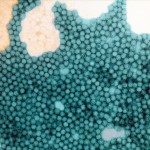Link to Pubmed [PMID] – 7966631
J. Virol. 1994 Dec;68(12):8386-91
Poliovirus (PV) type 1 mutants selected in human neuroblastoma cells persistently infected (PVpi) with the wild-type Mahoney strain exhibited a mouse-neurovirulent phenotype. Four of the five substitutions present in the capsid proteins of a PVpi were demonstrated to extend the host range of the Mahoney strain to mice. These new mouse-neurovirulent determinants were located in the three-dimensional structure of the viral capsid; two of them (residues 142 of VP2 and 60 of VP3) were located in loops exposed at the surface of the protein shell, whereas the other two (residues 43 of VP1 and 62 of VP4) were located on the inside of the capsid. VP1 residue 43 and VP2 residue 142 substitutions were also selected in a PVpi derived from the attenuated Sabin strain. We suggest that the selective pressure of human neuroblastoma cell factor(s) involved in early steps of PV multiplication could be responsible for the arising of amino acid substitutions which confer adaptation to the mouse central nervous system to PV.
